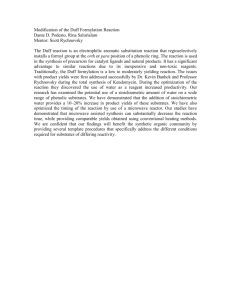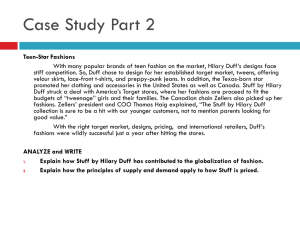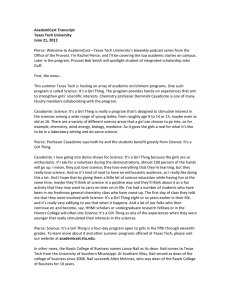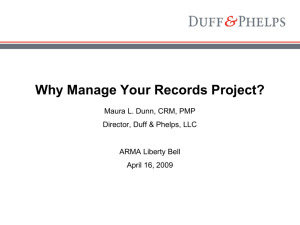Document 11630359
advertisement
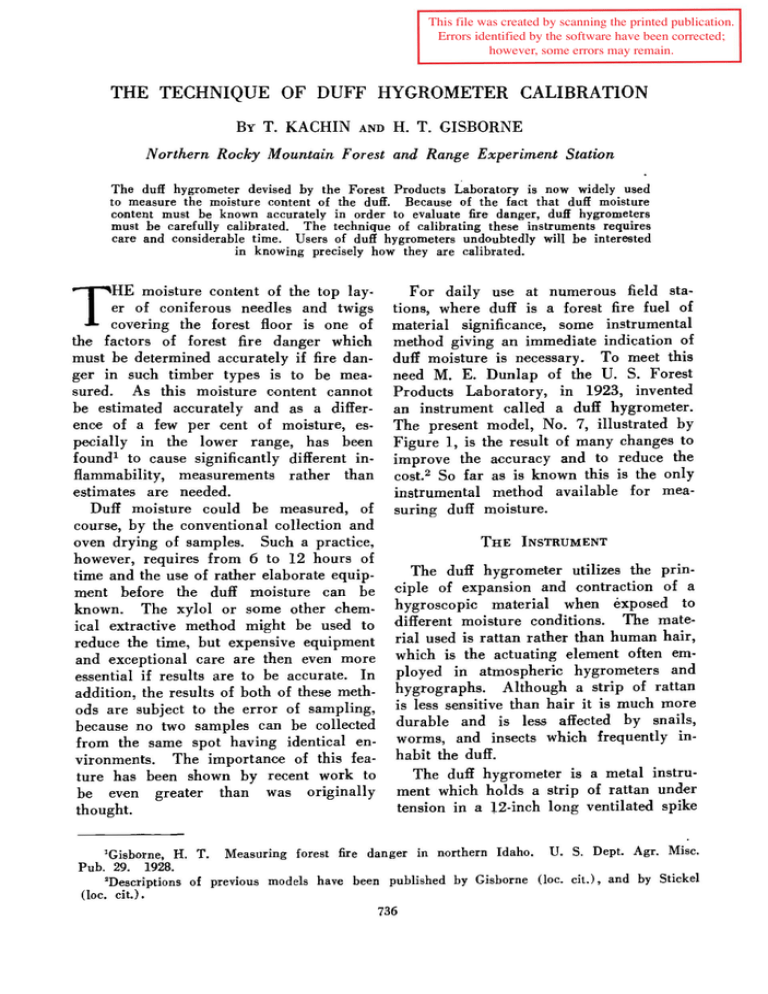
This file was created by scanning the printed publication. Errors identified by the software have been corrected; however, some errors may remain. THE TECHNIQUE OF DUFF HYGROMETER CALIBRATION BY T. KACHIN AND H. T. GISBORNE Nor them Rocky Mountain For est and Range Experiment Station The duff hygrometer devised by the Forest Products Laboratory is now widely used to measure the moisture content of the duff. Because of the fact that duff moisture content must be known accurately in order to evaluate fire danger, duff hygrometers must he carefully calibrated. The technique of calibrating these instruments requires care and considerable time. Users of duff hygrometers undoubtedly will he interested in knowing precisely how they are calibrated. T For daily use at numerous field staHE moisture content of the top lay· er of coniferous needles and twigs tions, where duff is a forest fire fuel of covering the forest floor is one of material significance, some instrumental the factors of forest fire danger which method giving an immediate indication of must he determined accurately if fire dan- duff moisture is necessary. To meet this ger in such timber types is to he mea· need M. E. Dunlap of the U. S. Forest sured. As this moisture content cannot Products Laboratory, in 1923, invented he estimated accurately and as a differ· an instrument called a duff hygrometer. ence of a few per cent of moisture, es· The present model, No. 7, illustrated by pecially in the lower range, has been Figure 1, is the result of many changes to found 1 to cause significantly different in- improve the accuracy and to reduce the flammability, measurements rather than cost. 2 So far as is known this is the only instrumental method available for meaestimates are needed. Duff moisture could he measured, of suring duff moisture. course, by the conventional collection and THE INSTRUMENT oven drying of samples. Such a practice, however, requires from 6 to 12 hours of The duff hygrometer utilizes the printime and the use of rather elaborate equip· ciple of expansion and contraction of a ment before the duff moisture can he hygroscopic material when exposed to known. The xylol or some other chem· different moisture conditions. The mateical extractive method might he used to rial used is rattan rather than human hair, reduce the time, hut expensive equipment and exceptional care are then even more which is the actuating element often emessential if results are to he accurate. In ployed in atmospheric hygrometers and addition, the results of both of these meth- hygrographs. Although a strip of rattan ods are subject to the error of sampling, is less sensitive than hair it is much more because no two samples can be collected durable and is less affected by snails, from the same spot having identical en- worms, and insects which frequently invironments. The importance of this fea- habit the duff. The duff hygrometer is a metal instruture has been shown by recent work to he even greater than was originally ment which holds a strip of rattan under tension in a 12-inch long ventilated spike thought. 'Gisborne, H. T. Measuring forest fire danger in northern Idaho. U. S. Dept. Agr. Misc. Pub. 29. 1928. 'Descriptions of previous mod els have been published by Gisborne (loc. cit.), and by Stickel (loc. cit.) • 736 THE TECHNIQUE OF DUFF HYGROMETER CALIBRATION so that changes in length of the rattan are shown by a pointer and scale enclosed in a fan-shaped housing attached to the spike. In actual use the spike is inserted horizontally in the duff, barely beneath the surface, so that as this layer changes moisture content the rattan changes with It, the position of the pointer indicating the duff moisture content. The instrument stays in the same spot throughout a season and may be reinserted season after season, readings being made as frequently as desired. So long as the instrument retains its calibration, or so long as replacements are accurately calibrated, the measurements are therefore fully compar· able, with the error of sampling entirely eliminated. CALIBRATION Necessity and Accuracy.-As all strips of rattan do not respond alike to moisture each instrument must be calibrated. As the response also varies with age or exposure to the weather each instrument must be calibrated at least once each year. Experience has shown that an accuracy of ± 0.5 per cent duff moisture is possible for moisture contents below 12 per cent, ± 1 per cent from 12 per cent to 18 per cent, ± 2 per cent from 18 per cent to 25 per cent, and ± 5 per cent from 25 per cent to 35 per cent. The maximum duff moisture above which rattans fail to indicate changes varies from 35 per cent to 50 per cent with different rattans. As duff will not carry fire when it has more than 25 per cent3 or 30 per cent moisture 4 this instrumental accuracy and range are satisfactory for field use in measuring fire danger. Choice of Method.-At least two meth· ods may be used for calibrating duff hy- 737 grometers. By the first method the instru· ments are exposed in duff of known mois· ture content, at various percentages between oven dry and 50 per cent, and the position of the needle. marked on the dial for each known or interpolated moisture content. The second method is based upon the fact that duff moisture is known when in equilibrium with any combination of air temperature and humidity such as naturally occurs under free air or forest conditions. Duff hygrometers there· fore may be subjected in air conditioned chambers to representative combinations of temperature and humidity, and the dial then calibrated directly in terms of duff moisture. As air conditioned chambers, maintain· ing satisfactorily constant conditions at any desired point throughout the range of temperature and humidity are not generally available, and as their cost is high this second method is seldom used. Material and Equipment.-Calibration by exposure in duff of known moisture content requires the following equipment: Electric oven, at least 16 inches deep by 24 inches wide and 18 inches high, in· side dimensions. Scales or balances of 1000-gram ca· pacity, and a sensitivity of one-tenth gram at near maximum load. About 2.5 kilograms of recently col· lected, top layer duff of the type in which the instruments are to be used. Fifteen duff containers, to be described. Six dozen No. 3 rubber stoppers. Forms for recording the data, cross· section paper, India ink, and an ounce of shellac. The duff containers or calibration tubes may be made in various forms. At the Northern Rocky Mountain Forest and Range Experiment Station they are made Gisborne, H. T. Measuring fire weather and forest inflammability. U. S. Dept. Agr. Circ. 1936. •Stickel, P. W. The measurement and interpretation of forest fire-weather in the western Adirondacks. N. Y. State Coli. of For. Tech. Pub. 34. 1931. 3 398. 738 JOURNAL OF FORESTRY from 18- or 20-gage galvanized iron. The tubes are about 15 inches long by 4 to 5 inches in diameter, with one end crimped and soldered air tight and the other end closed by a friction cap fitting as tightly as possible, yet being removable. The sides of the cap should overlap the sides of the tube about 3 inches. Such a can will hold from 125 to 150 grams of oven dry duff without packing. Two holes are bored in the end and in the cap of each container, of a size to be closed by a No. 3 stopper. Each tube is numbered or lettered on one side and on the cap. The containers are then oven dried at 100° C., removed from the oven and allowed to cool to room temperature, and the empty, dry weight determined and recorded. As the accuracy of calibra. tion of hygrometers will be no greater than one half of one per cent, and as the duff sample will weigh at least 100 grams, the tube and contents may be weighed to the nearest 0.5 gram. However, as most laboratory scales that might be used for this work are as easily read to the nearest 0.1 gram this degree of precision is recommended. For each duff hygrometer to be calib· rated at least one rubber stopper is bored so that the spike of the hygrometer can be inserted through it and fit snugly. The remaining stoppers are used in solid form to close the duff tube holes not being used by hygrometers. The stoppers need not be weighed because the tubes, empty or full of duff, should always be weighed without stoppers. A calibration record form found help· ful in· this work consists of a single sheet for each duff hygrometer with a main heading: "Instrument No. _______________ .. " Five column headings include: "1 Date, 2 Calibration tube No., 3 Weight of tube plus duff plus moisture, 4 Moisture con· tent in per cent, and 5 Instrument scale reading." Preparation of Duff Samples.-At least two methods of preparing duff samples are possible. By the first method the en· tire duff supply is brought to a uniform condition by sealing it in a container and shaking this frequently to mix the duff. After three or four days of such conditioning, samples are withdrawn, weighed, oven dried, and the moisture content de· termined. The average moisture content of these samples is assumed to be that of the main duff suoply, and the duff tubes may then be filled from this sup· ply, weighed, and the oven dry weight of the contained duff computed. Although this method obviates oven drying the duff used in the tubes, and thereby avoids the possibility of affecting the natural hygroscopicity of the material, it has not been found as accurate and dependable as the second method. By the second method the entire supply of duff to be used in the tubes is oven dried in open pans, by the following schedule: about 24 hours at 75 °, 24 hours at 85 °, 24 hours at 95 °, and 12 hours at 100° C. The empty duff tubes are in· serted in the oven for the last 15 minutes of this schedule and are then filled to capacity, 'but without forcible packing. The friction tops to the cans are put on and the filled cans are left in the oven, at 100° for a few hours more to remove all moisture. After this drying the con· tainers are quickly weighed. Speed and a warm, dry room are essential to prevent absorption of moisture. By subtracting the dry weight of the container, when empty, from the dry weight when full, the oven dry weight of the duff sample is de· termined. Tubes numbered 1 to 11 are then ar· ranged in order and water is added to the duff to bring the samples, respectively, to the following moisture contents: 2, 4, 6, 8, 10, 12, 15, 19, 25, 35, and 50 per cent. Less tubes and consequently fewer known moisture contents could be used, but experience with the above number and THE TECHNIQUE OF DUFF HYGROMETER CALIBRATION distribution of samples has been found well worth while. No water is added to the duff in tubes 12 to 15 until they are needed either as a check on one of the other samples or as a test for some intermediate moisture content. The holes in all tubes are then closed tightly with the solid rubber stoppers until the added moisture has diffused evenly throughout the duff sample. The diffusion of moisture can be has- TOP 0 d 739 tened, first by adding it by burette through each of the four holes, and second by returning the stoppered tubes to the oven, set at about 50° C., for an hour or two. After removal from the oven an additional 24 to 48 hours should be allowed for comnlete diffusion and absorption. After such preparation the stoppers are removed from each tube and it is weighed as a final check of the moisture eontent of each sample. This checking may re- VIEW 0 0 0 o o o o o eO> SlOE VIEW ADJVSTA8l£ POINT HORIZONTAL SECTION ON CENTER LINE /NCHEJ' l CAL/6/i'ATJOI( J'CALE 3 JCAL£ REVI.UP MIW 10, 19J1 CONE 8!~RtNG VERTICAL JECTION ON CENTER LINE DUFF HYGROMETER II$ DlPAifTIIIEHT OF ll"i'ltttLTttlfE FO/fUT.IE/IYICE FO/fi.JT I'IIOOl/CT.I LA!OifATOif'f' MIIOIJON WIUfiNJIN ICALt~OIITF~ O~N lr __l!1_LA__ (I(/) lr _ __ 7''0 6'1 ___LL___ " " ' Br _ _ NIIM8ill...L./!..:.1.1L ____l__..._.THElTJ Fig. 1.-Top and side views of a duff hygrometer showing important features involved in its calibration. 740 JOURNAL OF FORESTRY veal the need for adding moisture in some tubes, or the removal of moisture from some by further oven drying. It is not necessary, of course, to have exactly 10.00 per cent moisture in the 10 per cent tube; from 9.5 per cent to 10.5 per cent serves the purpose perfectly well. The moisture content should be computed, however, to an accuracy of one tenth of one per cent. While the duff tubes are being prepared old hygrometers should be cleaned and all instruments should be limbered up by subjecting them alternately to high and low moisture conditions. One purpose of this limbering process is to detect instru· ments lacking in spring tension, off the scale at one end or the other, having exceptionally sluggish rattans, or Qther· wise defective. This limbering up also is necessary in order to remove a "set" con· clition of the rattan which seems to result from storage under constant conditions. By wrapping the spikes in wet paper or cloth for 4 to 6 hours, then exposing the instruments to dry air in a room, or even an oven at about 38° C for a few hours, and repeating these processes two or three times, the rattans become much more sus· ceptible to accurate calibration. As an alternative method the instruments may be inserted first for a few hours in the 50 per cent test tube and then the 6 per cent or 8 per cent tube. This practice is not recommended, however, because of the possibility of removing and losing a small amount of duff with each extraction of the spike. Although the loss of such a small weight from a 150 gram sample is not material if it occurs only once or twice, several repetitions may result in an appreciable error. After all tubes have been brought to the desired moisture contents, and the duff hygrometers have been limbered up, the instruments are ~nserted, using the bored stoppers. A beginning may be made in any tube but the labor will be reduced ·by filling each tube with four instruments rather than scattering them among several tubes. After insertion in the first tube the instruments should be left at least 12 hours before the dials are read. Each d1al should be tapped gently until the needle comes to rest, then the reading is made. Scale Calibration.-At the outer edge of each duff hygrometer dial a scale of ten units, each unit subdivided into five equal parts, has been marked by the manufac· turer or by the Forest Products Labora· tory. This is indicated in Figure 1, as the "calibration scale." This scale is used in the original calibration and in each recalibration. Its purpose is merely to con· trol the distribution of duff moisture percent graduations, which make it possible to determine duff moisture directly from the instrument without use of a chart. A chart of the type shown by Figure 2 must be made, however, for each instrument before the duff moisture graduations can be linked on the hygrometer dial. After an instrument has been in a duff tube for a sufficient period the dial is tapped, the reading on the outermost or calibration scale is made and recorded on the calibration record form, the weight of tube and /contents is determined and recorded, and the duff moisture content computed and recorded. Separate, straightline ratio charts showing the duff moisture content for any total weight of tube, duff and moisture are an aid in reducing the time and preventing errors in this last computation. With these data recorded and checked, the duff hygrometer is then inserted m the tube of next higher or lower moisture content. If the movement is to a tube of not more than 5 per cent greater or less moisture than the last, the rattan can be expected to reach approximate equilibrium within a maximum of 6 to 8 hours, when new readings may be made. The length of this recommended period does not indicate that rattans are sluggish in response to changed moisture. As a test will show, an instrument registering say 8 per cent duff moisture will commence to respond THE TECHNIQUE OF DUFF HYGROMETER CALIBRATION within 30 seconds to the normal moisture of a person's hands grasping the spike. However, final equilibrium with the last one half of one per cent of moisture requires several hours. The last expansion or contraction of a rattan approaching equilibrium with duff of a certain moisture content is so slow that even when an instrument is left in a tube for 6 to 8 hours the reading reached after movement from the 8 per cent to the 10 per cent tube will not be exactly the same as when the movement has been from the 12 per cent to the 10 per cent tube. This lag is a well known phenomenon called hysteresis. Its effects can be elimmated either by leaving the hygrometers in each tube for 48 hours or more, or by obtaining both increasing and decreasing readings, first, with the rattan expanding toward equilibrium, and second with the rattan drying and contracting. The average of these two readings is then accepted DuFF as most accurate. It is essential that a duff hygrometer calibration curve, like Figure 2, should include readings obtained with the instrument moved progressively from low to high duff moistures and with the instrument moved progressively from high to low moistures. After scale readings have been obtained at all duff moistures included by the tubes these data are plotted on coordinate paper, and a smooth curve of best fit drawn as in Figure 2. A tabulation is then made showing the scale reading corresponding to duff moisture contents of 1 to 20 per cent, respectively, by single per cents, and for 25, 30, 35, and 50 per cent. From these data the instrument dial can be graduated so that the position of the needle pointer may be read directly in terms of duff moisture content. Graduating the Dial.-The face plate, shown in Figure 1 on which the dial is graduated should be removed from the - t- r- No./40 HYGROAIETER I CALIBRATED APR. OliFF MOISTIIR£ ,..0 I 2 3 _e- r" ./ I v 4 5 6 7 :.----' 8 !I 10 / II I I j ' lL 0 s 12 Ill 14 IS 16 17 18 111 20 25 30 liS so II. I 10 15 20 DuFF MoiSTURE zs 1931 INSTRII· M£NT SCALE (5 2./ 2.1S5 3./S 3.6 4.05 4.45 4.8S 5.20 s.ss 5.85 IS .IS 6.40 6.65 6.!10 7.15 7. 40 7.55 7.70 7.85 8.40 8.70 8.90 9.15 II II I I I I I I 30 35 40 741 45 50 CoNTENT IN PERCENT Fig. 2.-A duff hygrometer calibration curve. - t- - t- r- - ;-- r-- t- 742 JOURNAL OF FORESTRY instrument before attempting to mark new graduations on it. This must be done with care not to force the pointer to the right. The pointer may be moved to the left, toward lower moisture contents, without danger, however. The face plate should then be screwed or tacked firmly to a board, about 6 by 8 inches for cleaning and graduating. A small cloth moistened with alcohol should be used to clean the face plate and to remove former duff moisture scales no longer accurate. Care should be exercised, however, not to remove the calibration scale at the extreme outer edge of the plate. After the plate has dried it is given a light coat of shellac. When that is dry the plate is rubbed lightly with talcum or tracing cloth powder. Using the outer arc, along which the calibration scale of 1 to 10 is graduated, the center of this circle is found and two new concentric arcs are drawn on the face plate. The first should be drawn with a radius about % inch less than the outer scale arc. The second should have a radius % inch less than the outermost. This provides the space within which the duff moisture graduations are inked, each graduation being carefully drawn from the circle center to the exact calibration scale tabulated from the chart similar to Figure 2. Below the innermost arc the caption "Moisture content in per cent" is then lettered, as shown in Figure l. The six classes of relative inflammability may or may not be inscribed, as desired. A last coat of shellac is given to the dial face after all ink is dry. Final Calibration Check.-After the dial has been graduated the instrument should be checked in at least two and preferably four tubes. Checks at 4, 10, 20, and 35 per cent are recommended, first to determine whether the instrument has been thrown out of adjustment by the work on the face plate, and second to detect serious errors in graduating the plate. In these checks the instrument will be expected to read a fraction of a per cent low when in· serted in a can of higher moisture, and a fraction of a per cent too high when moved from a moist to a drier calibration tube. However, discrepancies exceeding the limits of error originally established as permissible should be investigated. Shipment and Field Checks.-As a duff hygrometer has its rattan held constantly under tension by means of wire wrappings and ties at each end of the rattan, and as these ties are held elsewhere by the adjustable spike tip or the movable needle mounting, hard jars or jolts are likely to impair the calibration. Consequently all instruments should be packed in resilient material and then securely boxed for shipment to field stations. Upon receipt of an instrument at a field station, it should be tested by the wet towel method to determine whether or not its calibration has been injured in transit. A towel is thoroughly saturated with water, wrung only slightly, then wrapped around the instrumept spike to cover it entirely. After such exposure for about 12 hours the pointer should come to rest at the highest, or 50 per cent, duff moisture graduation when the dial is tapped. If it does not do this, even after another 12 hours in a resoaked towel, the screw holding the adjustable spike tip should be loosened, without otherwise exposing the spike to dry air, and the tip moved until the needle pointer indicates the maximum duff moisture shown on the dial. lf the spike tip has not sufficient movement for this, the sliding block holding the needle mounting inside the housing should be adjusted. Between these two adjustments there is almost always sufficient movement to reset the instrument. If a rattan or tie wire has broken, however, the instrument will have to be returneJ to the calibrating laboratory for repair. THE TECHNIQUE OF DUFF HYGROMETER CALIBRATION 743 Tests of instrumental accuracy can be the instrument spike at the same depth made during the field season only by the below the duff surface, and to compact loss of one or two daily measurements, this duff around the spike as it was beunless extra instruments are available. fore the instrument was removed. If the accuracy is doubted, however, the Probably the best method of checking instrument can be removed from the duff a duff hygrometer in field use, if its accuand be given the wet towel test, adjust- racy is seriously doubted, is to call on ment being made if the needle pointer 'the regional calibrating laboratory for a fails to indicate the maximum duff mois- new instrument, returning the old one for ture graduated on the dial. ·such adjust- calibration tube test after the new one is ment may, however, introduce error in the received. lower moisture contents if it is made after CoNCLUSION more than four months' daily exposure of Although the technique of duff hygromthe instrument because by that time the eter calibration is rather time consuming rattan will have permanently stretched a and requires exceptional care, this instrufew thousandths of an inch and the pointer ment provides the only method at present can be expected to indicate slightly more available for quick and reasonably accuthan the maximum duff moisture shown rate measurements of duff moisture conby the original calibration. After such tent unaffected by the large error of cona test care should be exercised to insert ventional sampling.
